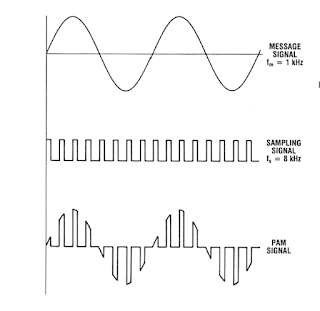Study of pulse amplitude modulation
Experiment No:
Experiment Name: Study of pulse amplitude modulation
AIM: To study sampling and reconstruction of Pulse Amplitude modulation system.
APP ARATUS REQUIRED:
1. PAM modulator
2.Oscilloscope.
3. Patch cords 2mm
4. Power supply
THEORY:
Pulse Amplitude Modulation - In Pulse Amplitude Modulation message information is encoded in the amplitude of a series of signal pulses. It is an analog pulse modulation scheme in which the amplitude of train of carrier pulse are varied according to the sample value of the message signal. A train of very short pulses of constant amplitude and fast repetition rate is chosen the amplitude of these pulse is made to vary in accordance with that of a slower modulating signal the result is that of multiplying the train by the modulating signal the envelope of the pulse height corresponds to the modulating wave .the Pam wave contain upper and lower side band frequencies besides the modulating and pulse signals. The demodulated PAM waves, the signal is passed through a low pass filter having a cut –off frequencies equal to the highest frequency in the modulating signal. At the output of the filter is available the modulating signal along with the DC component.
PAM has the same signal to noise ratio as AM. In PAM natural sampling, the pulse has varying top in accordance with signal variation. When these pulses are received at the receiver, it is always contaminated by noise. Then it becomes difficult to determine the shape of the top of the pulse and thus amplitude detection of the pulse is not accurate. Natural sampling uses chopping principle. This method is used practically if it satisfies Nyquist criteria. In this noise interference is minimum
Circuit Diagram:
PROCEDURE:
Modulation
Connect the function generator to produce a continuous analog message signal, typically a sine wave. Connect this signal to the signal sampler.
Use the pulse generator to produce a train of pulses at a frequency higher than twice the highest frequency component of the message signal (to satisfy the Nyquist criterion).
The sampler multiplies the message signal by the pulse train, producing a PAM signal where the amplitude of each pulse corresponds to the amplitude of the message signal at the sampling instance.
Connect the output of the sampler to the oscilloscope to observe the PAM signal.
Record the waveforms at different stages: the original message signal, the pulse train, and the PAM signal.
Demodulation
1. Connect the circuit as shown in figure
2. Given the modulated output with AFO used to the input of the circuit.
3. Vary the potentiometer so that modulating signal is obtained.
4. Measure the amplitude of the signal and verify with that of the input.
DISCUSSION:
The experiment successfully demonstrated the principles of Pulse Amplitude Modulation. By varying the amplitude of a pulse train in accordance with a message signal, we can effectively encode and later recover the original signal. Proper sampling frequency is essential to prevent aliasing and ensure accurate signal representation.





মন্তব্যসমূহ
একটি মন্তব্য পোস্ট করুন